“When the mists of sin no longer cloud the eye of your soul, you see that blessed vision clearly in the peace and purity of your own heart. That vision is nothing else than the holiness, the purity, the simplicity, and all the other glorious reflections of God’s nature, through which God himself is seen.” —Saint Gregory of Nyssa
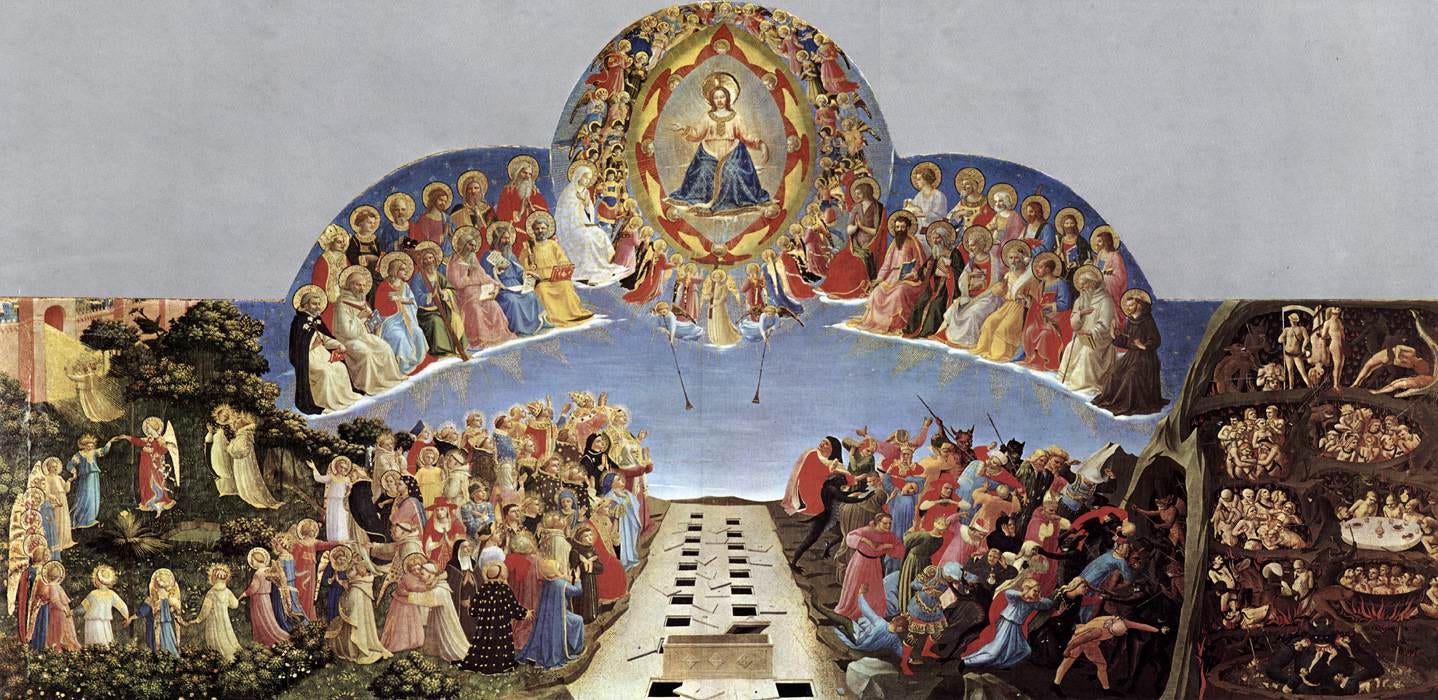
The first time I traveled to Europe, I was struck by how frequently I saw images of the Last Judgment. While in Italy I saw it on the west walls of churches, on domes, above church doors, on church doors, in museums, and even on pulpits. Before this experience, I had never seen this image, besides for Michelangelo's Sistine Chapel version in a textbook. Over the course of those eighteen years, I had probably been to at least fifty Catholic churches across America and never seen a Last Judgment mural or painting of any kind.
This isn’t that surprising. In America, we sanitize death as much as possible. Yet, even in our modern age, it comes for us and all those we love eventually. The Church will not let us forget death if we should attend to her. During Hallowtide, we celebrate the saints in heaven and pray for the faithful departed. In remembering the dead, we also think of our own death and are called to meditate on the four last things: death, judgment, heaven, and hell.
We confront the reality of the four last things in images of the Last Judgement. These paintings weave together various passages from the Bible about Heaven, Hell, and judgment. In fact, the icon carver Jonathan Pageau calls Last Judgment images “the synthesis of all Christian art.”1
In many ways, Fra Angelico’s Last Judgment closely follows the traditional iconography of Last Judgment paintings. Christ sits on a throne of light surrounded by angels and saints as he welcomes the blessed and turns away the damned, recalling the passage from Matthew:
When the Son of man shall come in his glory, and all the holy angels with him, then shall he sit upon the throne of his glory: And before him shall be gathered all nations: and he shall separate them one from another, as a shepherd divideth his sheep from the goats: And he shall set the sheep on his right hand, but the goats on the left. (Matthew 25:31-34)
Though it follows the traditional scheme, Angelico’s Last Judgment can hardly be called derivative. His depiction of Heaven is uniquely compelling. It’s difficult not to be moved by his vision of paradise where elegant angels dance with the beaming blessed in a beautiful and lively harmony. I love the way the late Dominican priest and art historian Fr. Vincenzo Marchese (d, 1891) describes it:
The greatest eloquence would fail to express the impression which this painting produces. The heart has a language which does not always speak in words, and we can never contemplate this picture without feeling in love with heaven.2
In grand artistic visions of Heaven and Hell— Dante’s Divine Comedy, Milton’s Paradise Lost, or Bosh’s Garden of Earthly Delights—it is usually Hell that sticks in the popular imagination. Not so in Fra Angelico. The dance of Paradise is the staying image in his painting. It is no wonder why. There is such tender conviviality among the blessed. They exude an earnest sweetness and look so glad to be with Christ and with each other. Yet, the painting is not saccharine. The integrity of the artist, a canonized saint himself, shines through the painting, as does his profound knowledge of scripture. And Hell is still sufficiently terrifying.
Hell
“In that place there will be weeping and gnashing of teeth.”—Matthew 13:42
On Christ’s left, demons round up the damned on a barren and rocky plane, shoving them into dark, cramped hovels. Cardinals, kings, monks, and bishops push and wail. Once they’re in hell, they appear stripped of their earthly trappings and even genders. Their punishments reflect the sins that consumed their lives, and their androgynous bodies reflect the bland sterility of Hell. There is no communion or fecundity in Gehenna. The damned are either unaware of their neighbor or aggressively devouring one another. Shadows reign. Even their complexions are darkened, and their eyes are sunken. Their physiognomies have begun to resemble the demons that taunt and torture them. They have rejected Christ and lost the light.
In this Dantesque depiction of Hell, Fra Angelico relies heavily on Buffalmaco’s painting of the Last Judgment, in which Hell is divided into seven bulges based on the seven deadly sins. Demons force gold into the mouths of those in the circle of the avaricious. Serpents immobilize the slothful. Snakes and toads attack the lustful. The wrathful bite and devour each other. The gluttonous are held back from plates of food. A three-headed Satan devours three bodies at the bottom.
Why all the grotesquery?
explains it well in her recent post: “Hell, then, was depicted not only to frighten but to urge the viewer toward repentance, reconciliation, and a life aligned with divine will, keeping the soul from suffering this ultimate, irreversible isolation from God.”3 Yet, Hell does not overwhelm the painting.Heaven
“Light intellectual replete with love, Love of true happiness, replete with joy, Joy, that transcends all sweetness of delight.”—Dante
When we look at the painting, our gaze is first drawn to the jarring aisle of open tombs that divide Heaven and Hell, reminding us of the resurrection of the dead from Revelation 20. Fra Angelico uses point perspective to lead our eyes to the bright, azure sky which serves as a throne for Christ. This imagery draws on Exodus 24:10, “they saw the God of Israel; and there was under his feet as it were a paved work of sapphire stone, and as it were the very heaven for clearness.”
Rays of light emanate from Christ and his robes. Hosts of angels surround him and sing of his splendor. Christ holds the painting and all of reality together.
“All things were created through him and for him. He exists before all things, and in him all things hold together' (Col 1:16-17).
Although we may find beautiful details to revel in, Angelico does not let us forget that it is Christ in whom the Blessed live. They all look to him and are animated by his light. As Pope Benedict XVI wrote in his book Eschatology, “One is in heaven when, and to the degree, that one is in Christ. It is by being with Christ that we find the true location of our existence as human beings in God.”4
Two angels blow trumpets to signal the second coming and the resurrection of the dead. Another Angel holds the cross below Christ, reminding us that it is only through Jesus’s death and resurrection that we attain the splendor of Heaven. In his depiction of Heaven, Fra Angelico abandons point perspective. Heaven does not conform to a linear perspective and is free of earthly time and constraints.
Clothed in glory and light for the wedding feast, the blessed ascend the mountain of paradise where they enter the walls of the heavenly Jerusalem and reign with Christ forever. Their clothes and faces “shine like the sun” as the body of Christ shone in the Transfiguration. They have become holy, whole, and perfect, more themselves.
While the damned have lost their individuality, the blessed are now both more unified and more distinct than they ever were on earth. A knight clothed in blue and gold looks up in gratitude as he humbly folds his arms over his chest. A monk of the Camaldolese order tenderly embraces his guardian Angel. Some fall on their knees and clasp their hands together in heartfelt gratitude and joyous praise of the Creator. Some engage in holy conversation with each other or with their guardian angels. There are nuns and knights, cardinals and shepherds, monks and kings, bishops and laypeople.
The painting brings to life Pope Benedict XVI’s description in his book on Eschatology:
The integration of the "I' into the body of Christ, its disponibilité (receptiveness) at the service of the Lord and of others, is not the self's dissolution but a purification which is, at the same time, the actualization of its highest potential. This is why heaven is individual for each and every one. Everyone sees God in his own proper way. Everyone receives the love offered by the totality in the manner suggested by his own irreplaceable uniqueness.5
In this painting, Heaven is more interesting, more vivid, more spacious, and more attractive than Hell, which is horrifying, yes, but also dull, cramped, and tedious.
While hell is barren, the verdant mountain of Paradise is bursting with life. The garden is lush, and the plants are abundant: palm trees, pomegranates, roses and other flowers all grow together on the holy mountain, recalling Eden and the Song of Solomon. It’s all beautiful and also deeply symbolic as
reminds us in a recent piece on the medieval symbolism of flowers.6 In the Bible, a beautiful garden is not only a metaphor for Paradise but also for the soul that makes a place for God.The heavenly mountaintop also recalls the numerous mountaintop meetings between God and man throughout the Bible as well as the prophecies such as this one from the book of Micah
In the last days the mountain of the Lord’s temple will be established as the highest of the mountains; it will be exalted above the hills, and peoples will stream to it. (Micah 4:1)
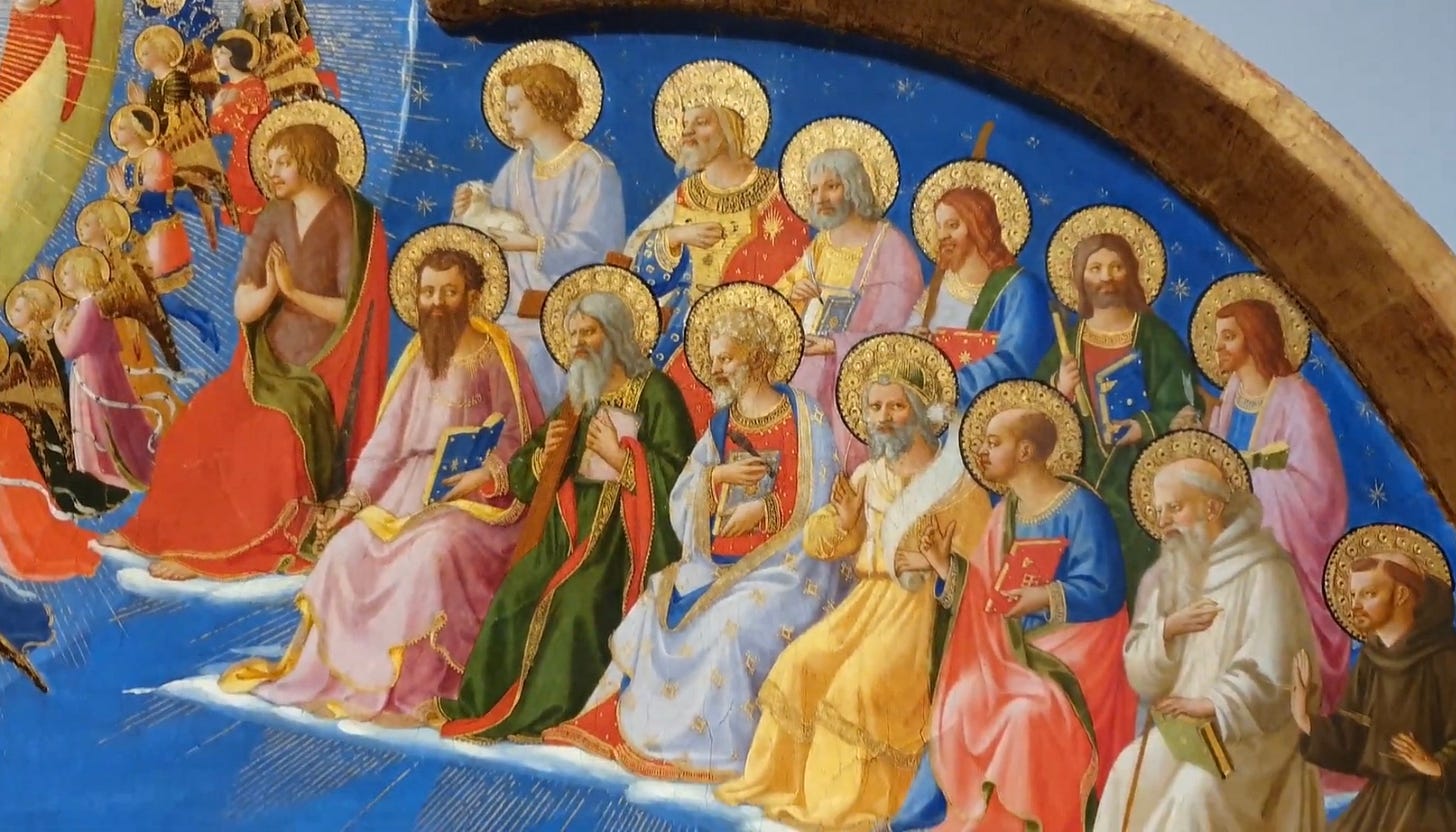
As we move up the mountain, we see the saints in the heavenly court who look to God and each other with glad glances as they sit on their thrones surrounding Christ. These great saints are seated in a higher position than their compatriots in the garden below, and even appear to participate in Christ’s judgment as evidenced by their own elevated thrones. In fact, there are multiple verses throughout Scripture that say the saints and ancients of Israel will judge with God, from Isaiah 3:14 to the Gospel of Saint Matthew and 1 Corinthians 6:2–3.
Jesus said to them, “Truly, I say to you, in the new world, when the Son of man shall sit on his glorious throne, you who have followed me will also sit on twelve thrones, judging the twelve tribes of Israel.(Matthew 19:28)
We can spot Saint Dominic and Saint Francis on either end of the heavenly rows among various apostles and Old Testament figures. These saints surrounding Christ certainly play an important part in the heavenly hierarchy. Yet the saints at the bottom do not appear envious or vindictive that others have surpassed them. They celebrate the saints who sit with Christ and raise their arms in gratitude and praise.
Their robes glimmer with the heavenly light and seem to retain some mark of their earthly life in their heavenly garments. Perhaps this reflects how the work in their earthly offices participates in the Heavenly kingdom.
While speaking on a different icon of the last judgment, Jonathan Pageau reminds his audience that “the last judgment is something that is already happening now.” It is not just a distant reality. Although “we see but through a glass darkly,” we can still participate in the resurrection through the sacraments. We can choose to follow the heavenly angels and allow the grace of God to permeate our souls or we can let our sins consume us and lead us to the second death.
Although Fra Angelico includes many recognizable saints, he also includes many who are not, reminding us of all the saints who lived holy, hidden lives and are not officially canonized but recognized by Christ among the blessed. These unknown saints are among the ones who dance with angels in what is perhaps the most memorable part of the painting: the heavenly dance. Art critics often praise Angelico for this “innovation,” and while it is unique in painting, the imagery of the dance is biblical and present in commentaries of the Cappadocian fathers.7
Drawing on David’s dance before the arc, Saint Basil the Great writes in a homily
Fix thine eyes on the heavenly riches, and on the treasure which thou hast put by for thyself through thy good work…Thou hast angels, with whom thou shalt dance about the throne of God, and shalt be glad with everlasting joy.8
The dance represents how all in heaven are unified by the perfect harmony and rhythm of the Creator’s song.
elaborates on this theme often on his substack and here writes about the way the Cappadocian Fathers used the metaphor:In the 4th century AD, St. Gregory of Nyssa, St. Gregory of Nazianzus, and St. Basil of Caesarea coined the term "perichoresis" to describe the trinitarian dynamic between Father, Son, and Holy Spirit. Literally, the word means "circle dance." For them, God was the eternal circular flow of love. Eternal dance.9
Fra Angelico also probably would have heard songs and hymns that mention this heavenly dance. I will leave you with one such verse by the Franciscan friar and poet Jacapone de Todi (d. 1306), a verse Angelico surely had in mind as painted the saints in heaven.
Dance they in a ring in heaven, All the Blessed in that garden, Where the love divine abideth, Which is all aglow with love.
In that ring dance all the Blessed, In that ring dance all the angels. Go they all before the Bridegroom, Dancing all of them for love.
In that court is joyfulness Of a love that's fathomless. All of them go to the dancing, For the Saviour whom they love.
Clad are they in coloured raiment, White and red and variegated. Crowned they are with wreaths of flowers. Like to lovers are they all.
All of those thus crowned with garlands Look like youths of thirty summers. In that court is life abundant, Everything is full of love.10
This painting is so rich. I would love to hear what your favorite details are. What are you drawn to in the painting?
J. B. Supino (1902). Fra Angelico, 77
Ratzinger, 234
Ratzinger, J. (2007). Eschatology: Death and the Eternal Life (Second Edition). CUA Press. 235
The Cappadocian Fathers are particularly relevant to this painting because Amgrogio Traversari, the Prior who commissioned the painting for his monastsry, translated many of their works from Greek. Critics think that he may have had some influence on the painting. Of course, Fra Angelico probably would have been familiar with their homilies apart from Traversari’s influence from his own studies as a Dominican brother.
https://www.ccel.org/ccel/schaff/npnf208.vi.ii.v.html
https://www.google.com/books/edition/Fra_Angelico/45o5AAAAMAAJ?hl=en




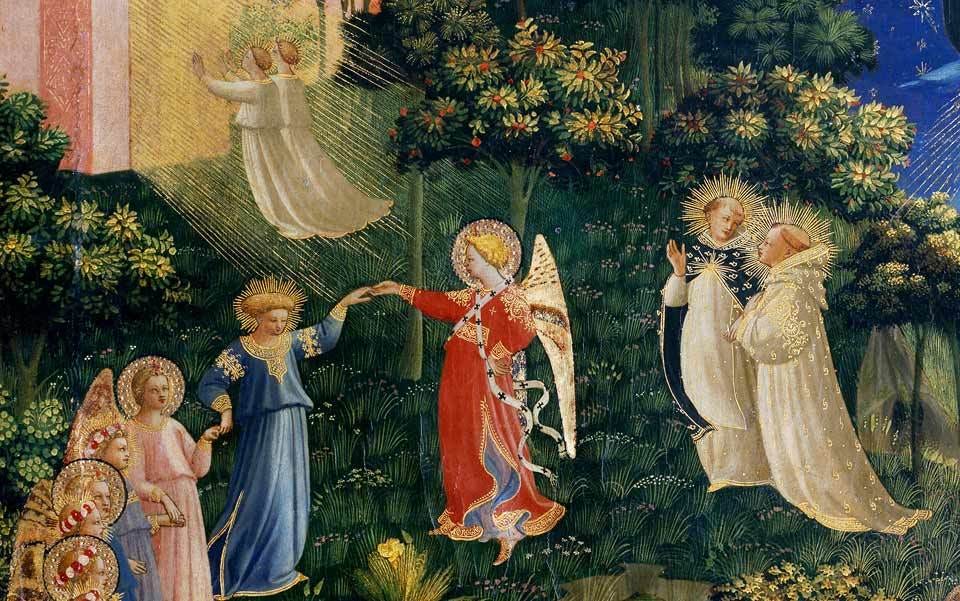
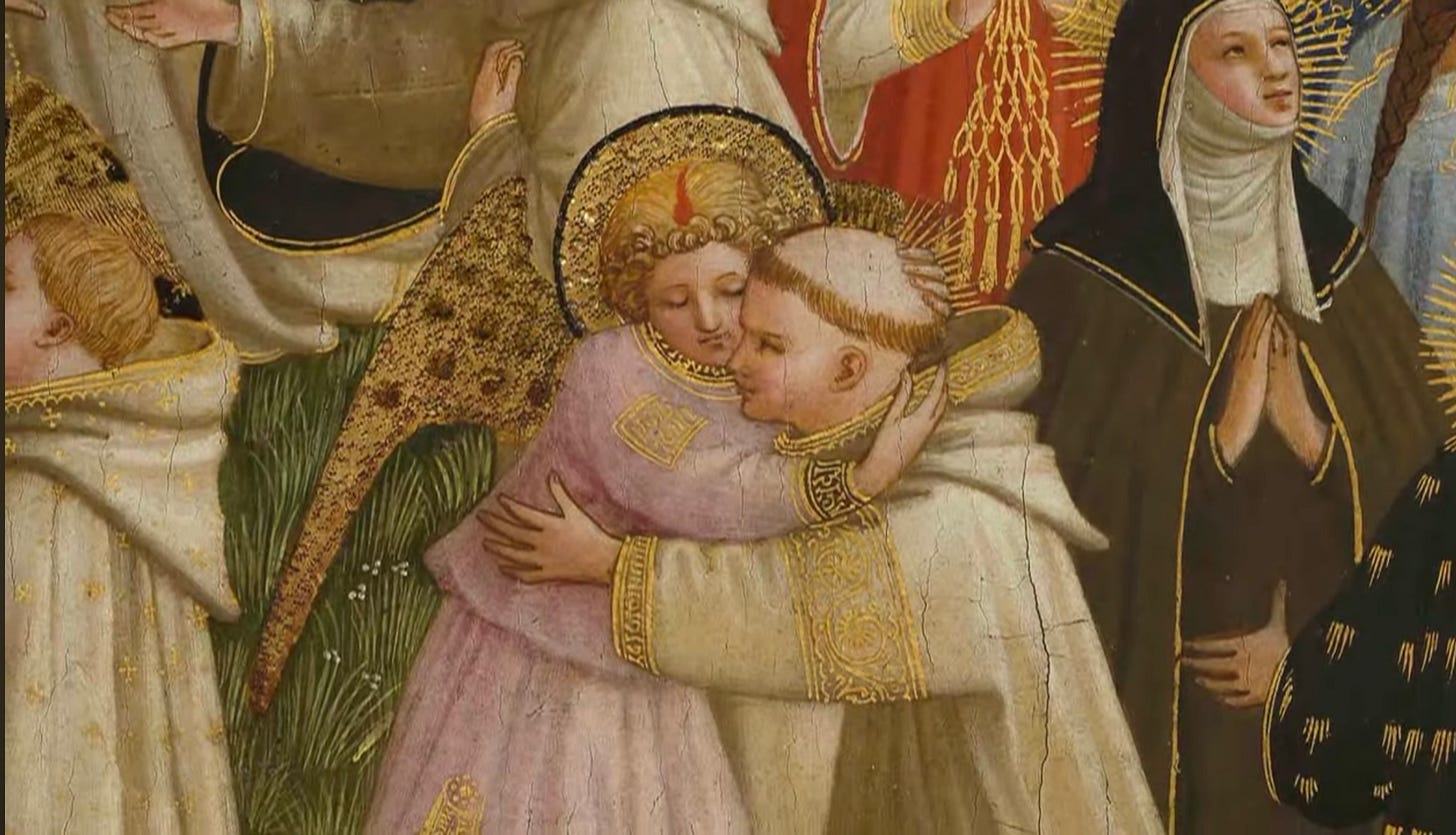
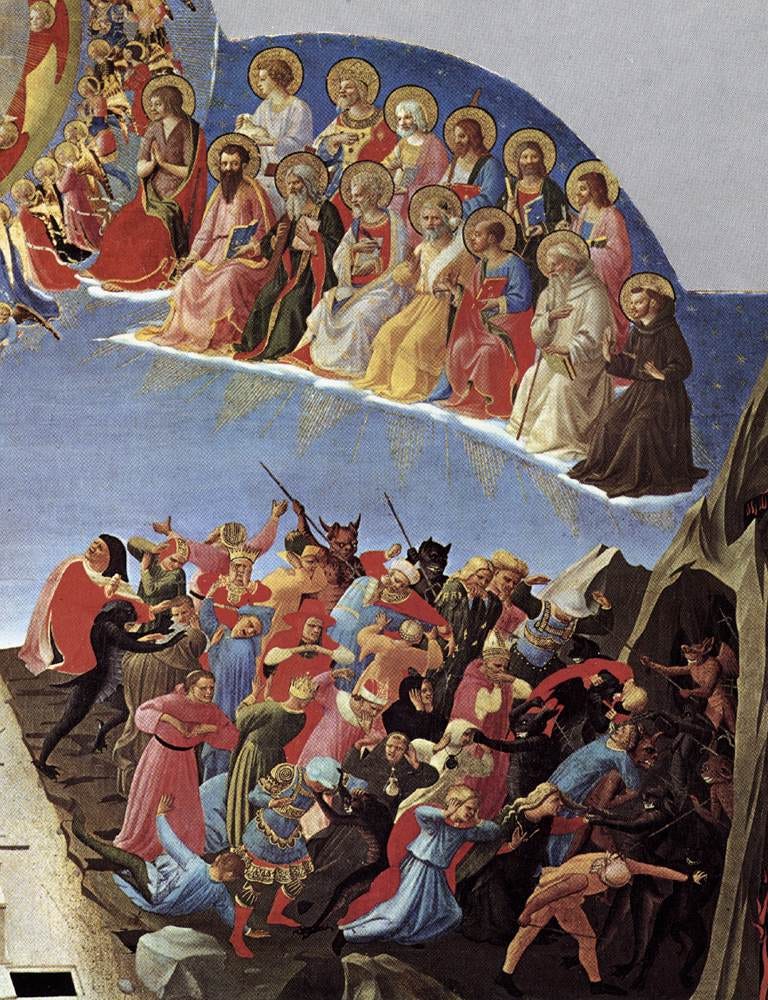
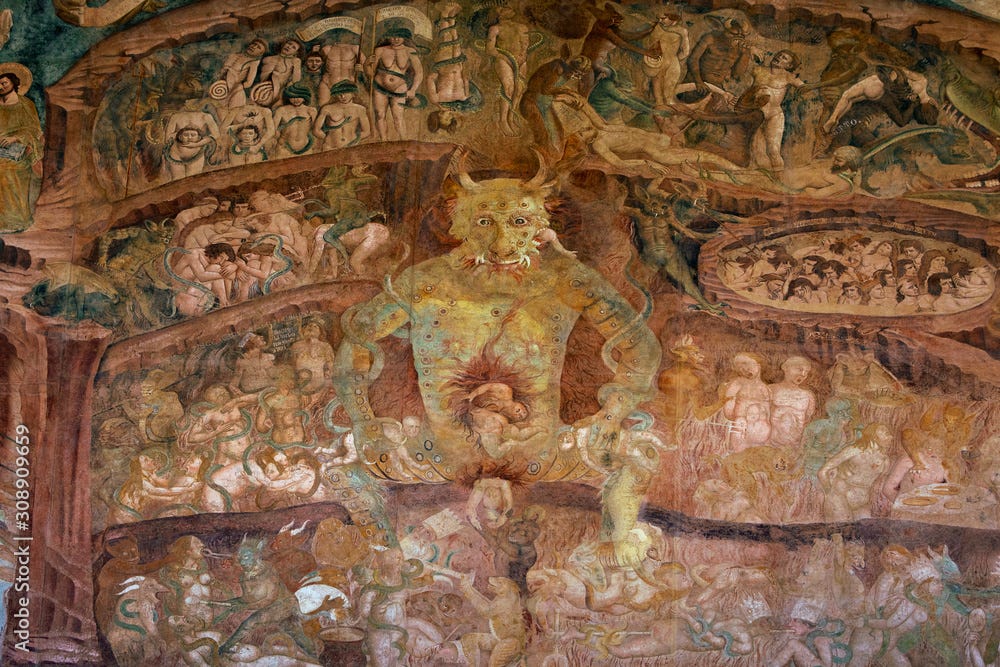

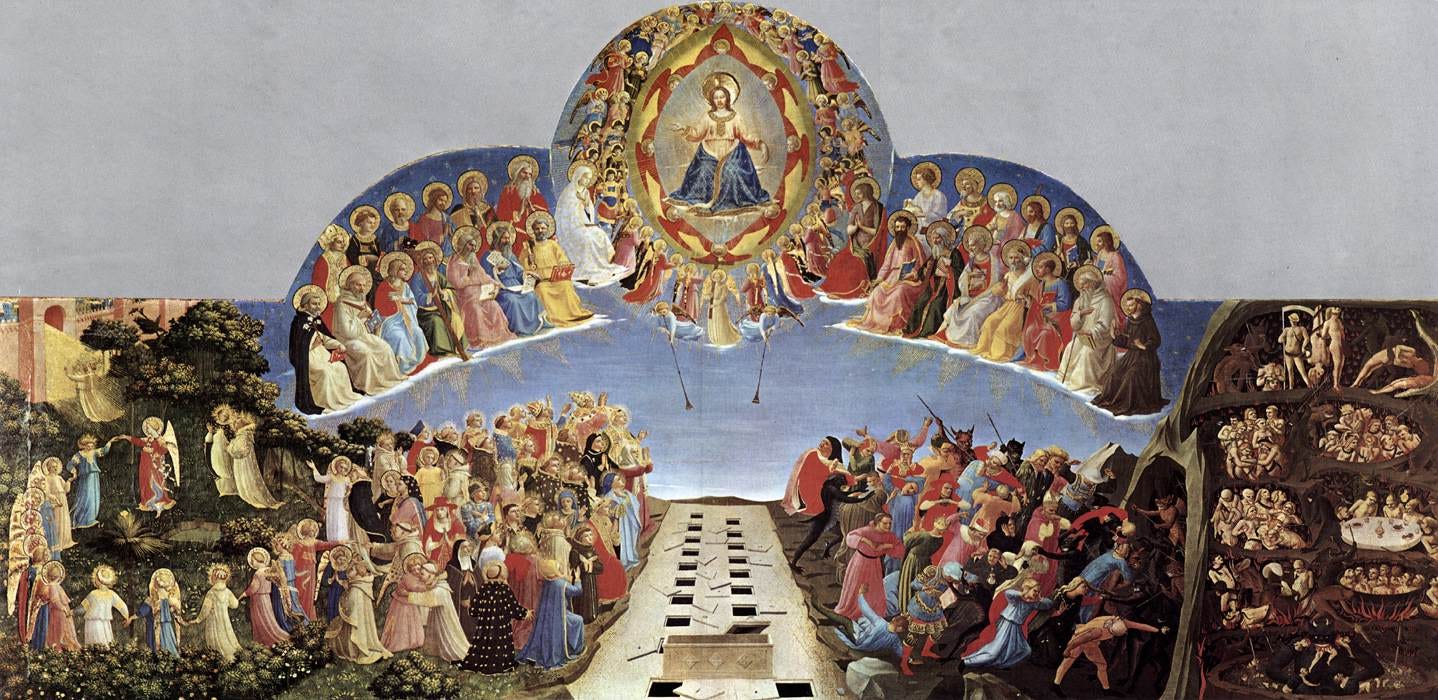
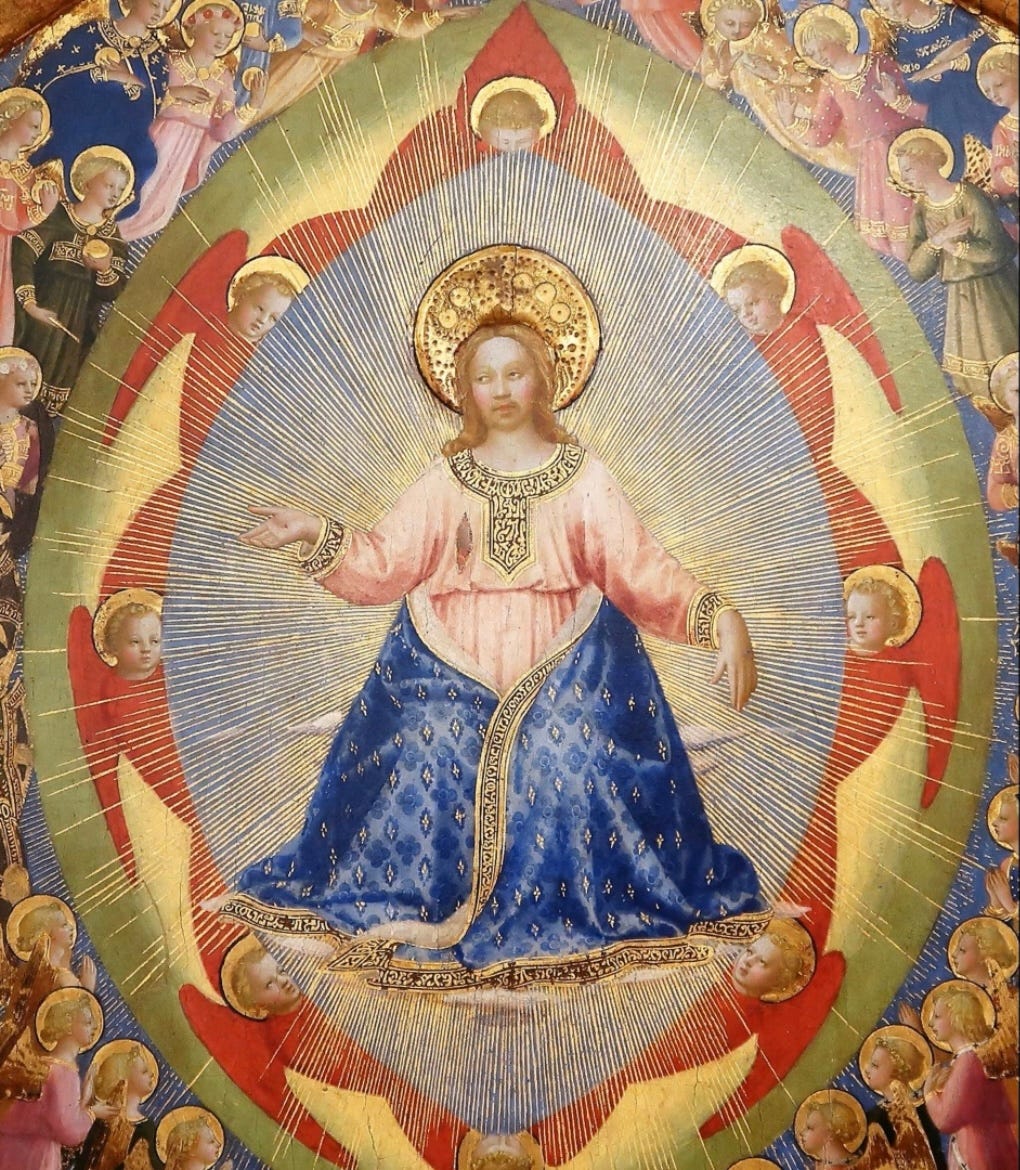
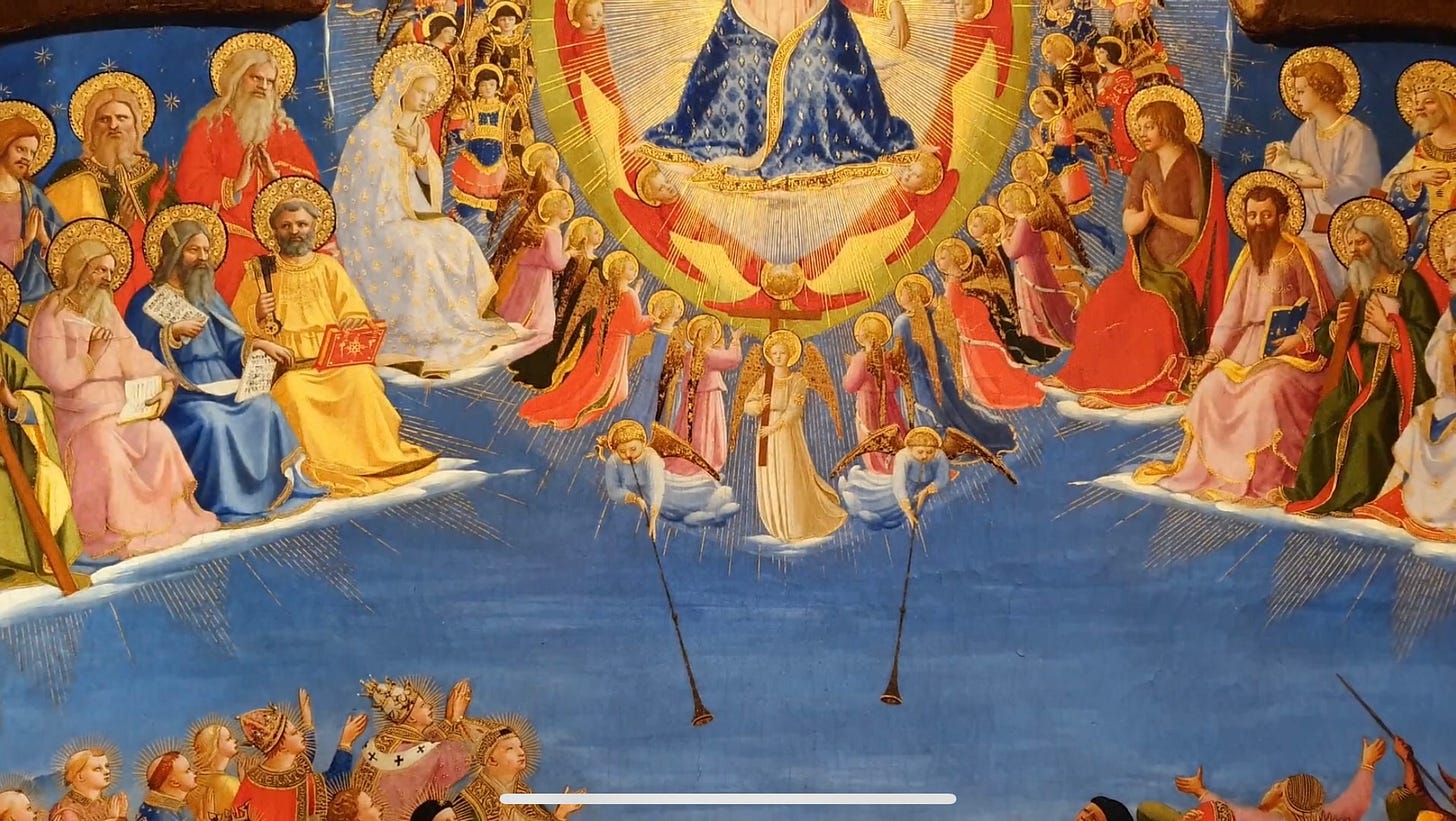
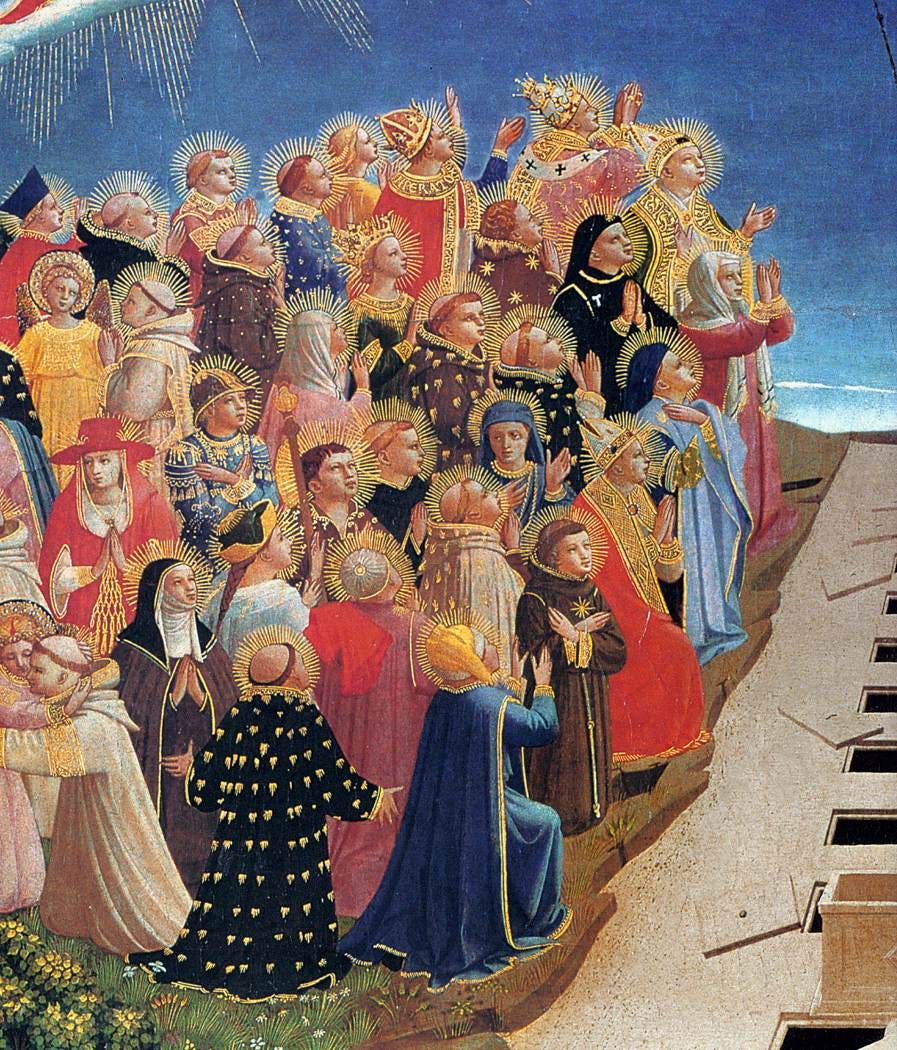
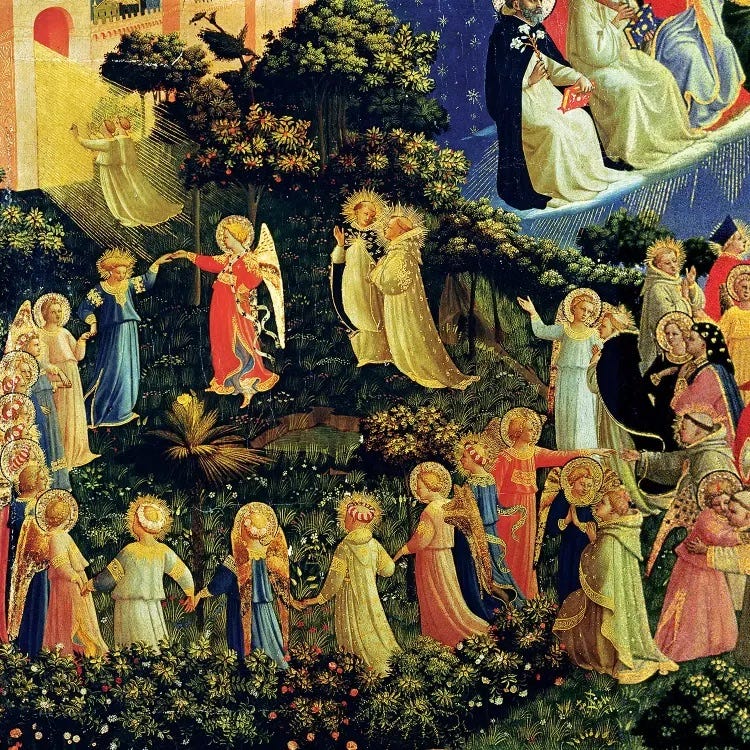
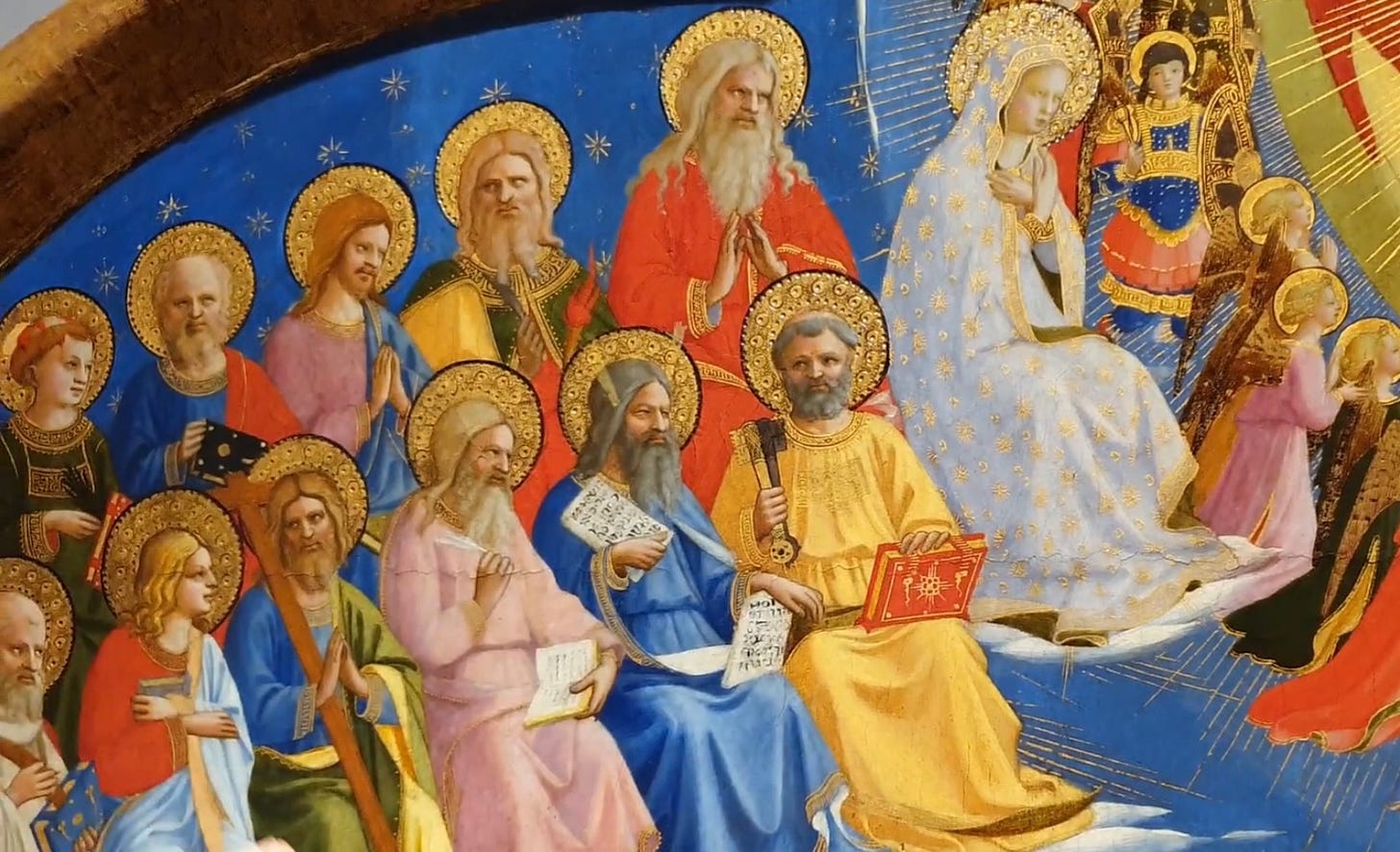
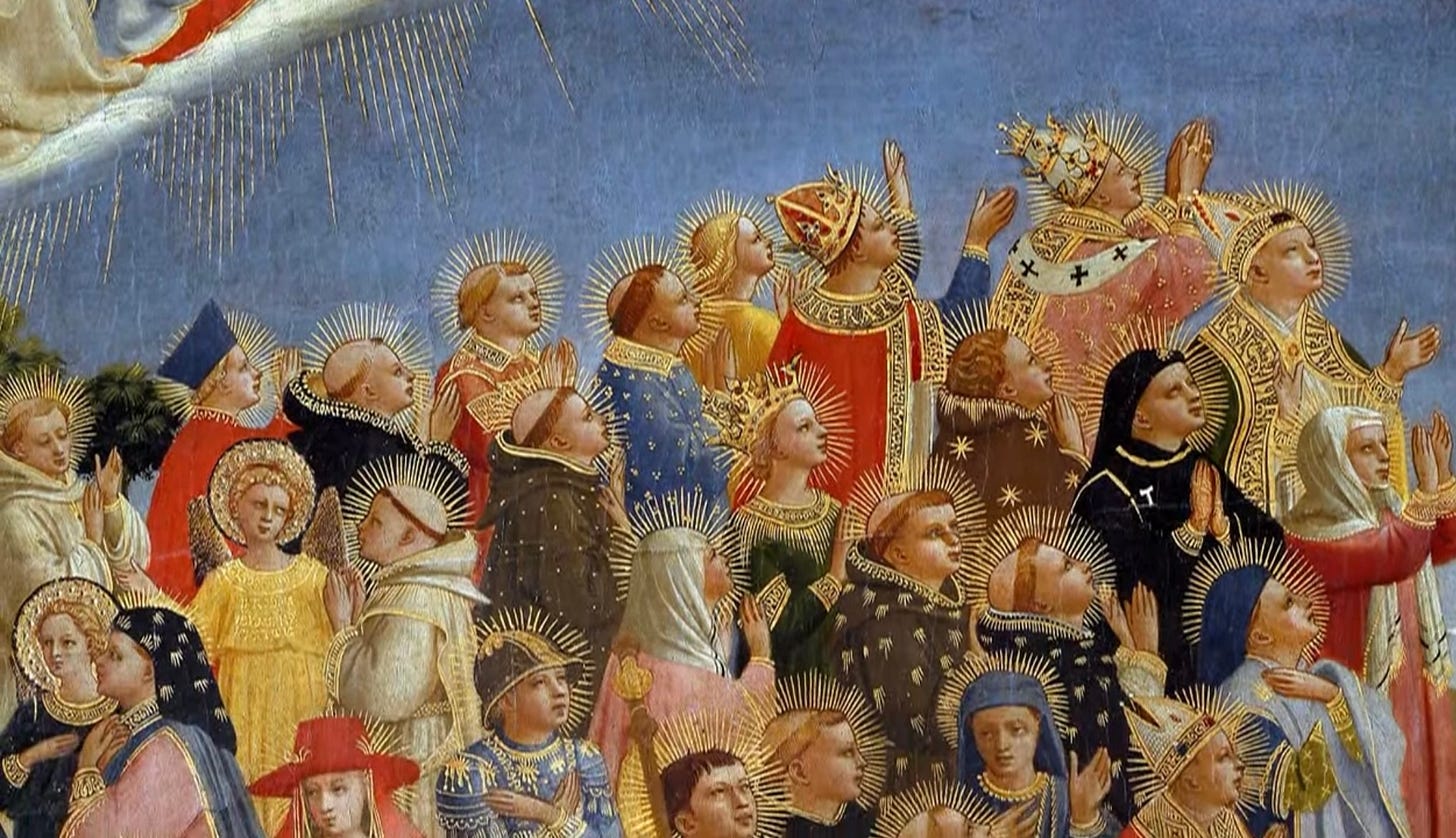
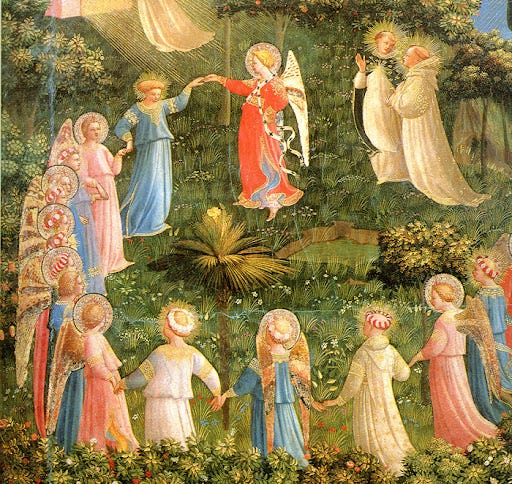



Truly brilliant work. Thank you for this… the image of Heaven on Hallow’s Eve today has lifted my soul.
This is absolutely fantastic. Your writing is so exceptional. The way you wove together a commentary on all of these paintings felt like it had narrative tension leading from paragraph to paragraph. Thank you so much for this